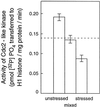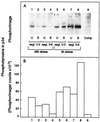Effect of water stress on cell division and cell-division-cycle 2-like cell-cycle kinase activity in wheat leaves
- PMID: 9625720
- PMCID: PMC34987
- DOI: 10.1104/pp.117.2.667
Effect of water stress on cell division and cell-division-cycle 2-like cell-cycle kinase activity in wheat leaves
Abstract
In wheat (Triticum aestivum) seedlings subjected to a mild water stress (water potential of -0.3 MPa), the leaf-elongation rate was reduced by one-half and the mitotic activity of mesophyll cells was reduced to 42% of well-watered controls within 1 d. There was also a reduction in the length of the zone of mesophyll cell division to within 4 mm from the base compared with 8 mm in control leaves. However, the period of division continued longer in the stressed than in the control leaves, and the final cell number in the stressed leaves reached 85% of controls. Cyclin-dependent protein kinase enzymes that are required in vivo for DNA replication and mitosis were recovered from the meristematic zone of leaves by affinity for p13(suc1). Water stress caused a reduction in H1 histone kinase activity to one-half of the control level, although amounts of the enzyme were unaffected. Reduced activity was correlated with an increased proportion of the 34-kD Cdc2-like kinase (an enzyme sharing with the Cdc2 protein of other eukaryotes the same size, antigenic sites, affinity for p13(suc1), and H1 histone kinase catalytic activity) deactivated by tyrosine phosphorylation. Deactivation to 50% occurred within 3 h of stress imposition in cells at the base of the meristematic zone and was therefore too fast to be explained by a reduction in the rate at which cells reached mitosis because of slowing of growth; rather, stress must have acted more immediately on the enzyme. The operation of controls slowing the exit from the G1 and G2 phases is discussed. We suggest that a water-stress signal acts on Cdc2 kinase by increasing phosphorylation of tyrosine, causing a shift to the inhibited form and slowing cell production.
Figures









Similar articles
-
Quantitative analysis of cell division in leaves: methods, developmental patterns and effects of environmental conditions.Plant Mol Biol. 2000 Aug;43(5-6):555-67. doi: 10.1023/a:1006438321386. Plant Mol Biol. 2000. PMID: 11089860 Review.
-
Autographa californica nucleopolyhedrovirus infection results in Sf9 cell cycle arrest at G2/M phase.Virology. 1998 Apr 25;244(1):195-211. doi: 10.1006/viro.1998.9097. Virology. 1998. PMID: 9581791
-
[From ovocyte to biochemistry of the cell cycle].Verh K Acad Geneeskd Belg. 1991;53(4):365-85. Verh K Acad Geneeskd Belg. 1991. PMID: 1659057 Review. French.
-
Relevance of histone H1 kinase activity to the G2/M transition during the cell cycle ofDictyostelium discoideum.J Plant Res. 1997 Mar;110(1):81-5. doi: 10.1007/BF02506846. J Plant Res. 1997. PMID: 27520047
-
Requirement for p34cdc2 kinase is restricted to mitosis in the mammalian cdc2 mutant FT210.J Cell Biol. 1992 Jun;117(5):1041-53. doi: 10.1083/jcb.117.5.1041. J Cell Biol. 1992. PMID: 1533642 Free PMC article.
Cited by
-
The agony of choice: how plants balance growth and survival under water-limiting conditions.Plant Physiol. 2013 Aug;162(4):1768-79. doi: 10.1104/pp.113.220921. Epub 2013 Jun 13. Plant Physiol. 2013. PMID: 23766368 Free PMC article. Review.
-
Functional characterization of the diatom cyclin-dependent kinase A2 as a mitotic regulator reveals plant-like properties in a non-green lineage.BMC Plant Biol. 2015 Mar 14;15:86. doi: 10.1186/s12870-015-0469-6. BMC Plant Biol. 2015. PMID: 25887918 Free PMC article.
-
Quantitative analysis of cell division in leaves: methods, developmental patterns and effects of environmental conditions.Plant Mol Biol. 2000 Aug;43(5-6):555-67. doi: 10.1023/a:1006438321386. Plant Mol Biol. 2000. PMID: 11089860 Review.
-
Regulation of cyclin-dependent kinases in Arabidopsis thaliana.Plant Mol Biol. 2000 Aug;43(5-6):583-93. doi: 10.1023/a:1006409907831. Plant Mol Biol. 2000. PMID: 11089862 Review.
-
Chilling and Drought Stresses in Crop Plants: Implications, Cross Talk, and Potential Management Opportunities.Front Plant Sci. 2018 Apr 10;9:393. doi: 10.3389/fpls.2018.00393. eCollection 2018. Front Plant Sci. 2018. PMID: 29692787 Free PMC article. Review.
References
-
- Beemster GTS, Masle J, Williamson RE, Farquhar GD. Effects of soil resistance to root penetration on leaf expansion in wheat (Triticum aestivum L.): kinematic analysis of leaf elongation. J Exp Bot. 1997;47:1663–1678.
-
- Bergounioux C, Perennes C, Hemerly AS, Qin LX, Sarda C, Inzé D, Gadal P. Relation between protoplast division, cell-cycle stage and nuclear chromatin structure. Protoplasma. 1988;142:127–136.
-
- Bitonti MB, Ferraro F, Floris C, Innocenti AM. Response of meristematic cells to osmotic stress in Triticum durum. Biochem Physiol Pflanz. 1991;187:453–457.
LinkOut - more resources
Full Text Sources
Other Literature Sources
Miscellaneous

